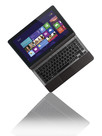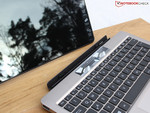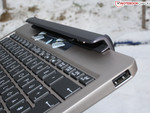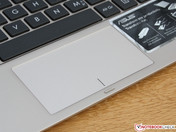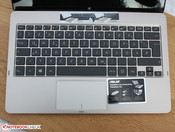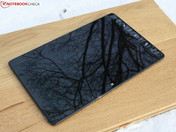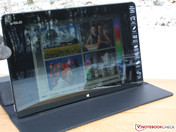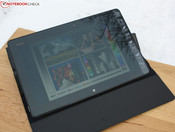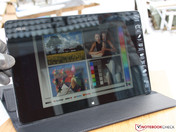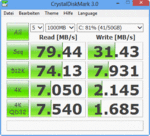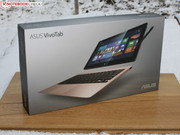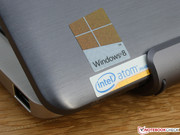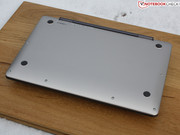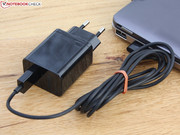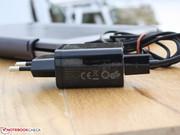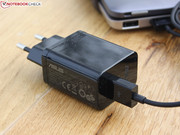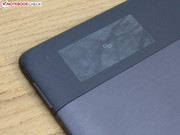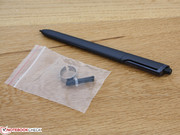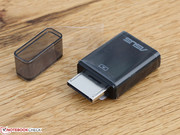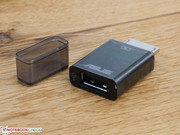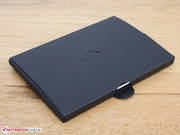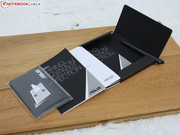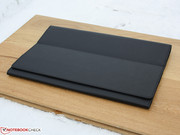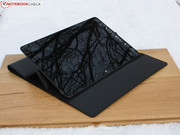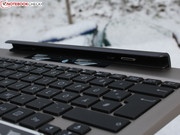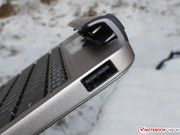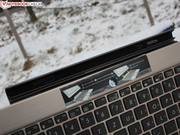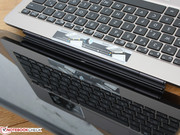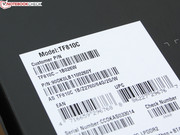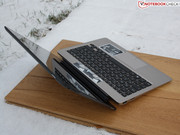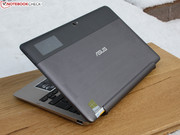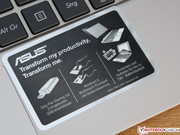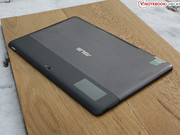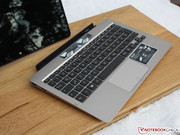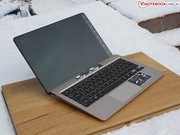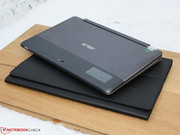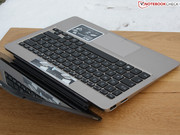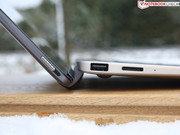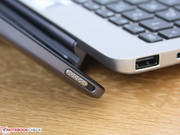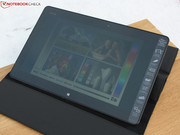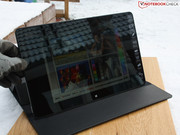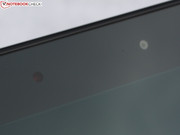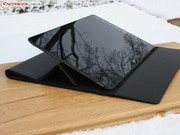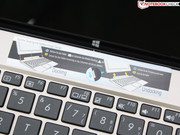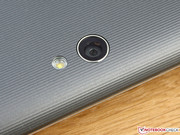Review Asus VivoTab TF810C Convertible

For the original German review, see here.
IFA 2012 was the revival of convertibles. To this point subnotebooks with a classic swivel joint were niche products. For the most part these devices, like the convertible Lifebooks (e.g. Fujitsu T580, T900), Latitudes (Dell XT2) or ThinkPads (X220T) were attractive for the business user. There have been some Windows 7 consumer convertibles over the last couple of years, but the sales figures were never really high.
The most important consumer convertibles: Lenovo IdeaPad S10-3t (N450), HP TouchSmart tm2 (Core 2 Duo), Dell Inspiron duo (N550), Gigabyte Booktop T1125N (Intel Core) and Asus Eee PC T91 MT (Z520). Reason for the small demand was the bad touch optimization of Windows 7 and a market that was heavily focused on notebooks.
The massive growth of Android and iOS based tablets and their big performance jumps in a very short period got the attention of Intel and Microsoft. The big players did not want to lose against Android in the long term but sell their own processors for tablets and smartphones. Windows 8 was also optimized to become a touch-OS and Intel made ultra-mobile X86-Atom CPUs (Clover Trail) for tablets and smartphones (Windows Phone).
The VivoTab TF810C belongs to this "new" category. Atom Z2760 combined with real Windows 8 (no RT-version) and an attachable keyboard. Can the 11.6-inch device connect the typical Windows world and its proven applications with the mobile tablet world? Asus talks about transformed productivity and not only attaches a convenient keyboard but also a second battery. Do mobility and Windows productivity meet the requirements of the 900 Euros (~$1201) price tag?
Case
Similar to HP and Acer, Asus decided to use the docking concept. But this is only one way to transform a tablet into a subnotebook. Flipping frame (Review Dell XPS 12 ConvertibleDell XPS 12), slider-mechanism (Sony Vaio Duo 11, Toshiba Satellite U920t), double-sided displays (Asus Taichi 21) and 360-degree hinges (Lenovo IdeaPad Yoga) are other solutions.
Advantage of the docking system: If you do not need the keyboard - or in this case the longer runtime - you do not have to carry a bulky and heavy case. The first look is reserved for the massive metallic joint of the 11.6-inch device. Two bars inside keep the tablet in place and a velvet insert avoids unpleasant abrasions. Moving the joint is very difficult without the cover as lever-arm, it is exceptionally firm. Accordingly opening the cover with one hand is not possible.
The slider on the left tablet side releases the locking mechanism mechanically. The connection has a very good tensile strength, without unlocking the tablet cannot be released. The joint cannot avoid teetering of the cover; it is too loose in the socket.
The opening angle of the cover is limited to around 130 degrees and the heavy base unit (weight of the second battery) avoids tipping backwards. Touch inputs encounter a usable fixated surface but the wobbling within the joint is disturbing. The Samsung ATIV Smart PC and HP Envy X2 have the same problem. Especially problematic for Samsung users: The opening angle is smaller, the device can tip due to the unfavorable center of gravity (no battery weight underneath the keyboard) and the display falls back onto the keyboard by itself (no fixation point).
We really like the stability and build quality of both components. The glass has good pressure resistance, only at the border surfaces pressure creates small pressure marks. The brushed aluminum finish of the back side of the tablet is pleasantly cool and avoids slipping of the hands. The ripped plastic stripes at the same place have the same purpose.
The keyboard-dock leaves the same sturdy impression of the tablet body. It is made of brushed aluminum at the cover and rubberized plastic underneath. The base can only be slightly bent but not dented anywhere.
Connectivity
The combination of tablet and keyboard dock enables a high number of ports beneath the keyboard. Asus integrates two standard USB 2.0 ports but waives the micro-USB port at the tablet. One USB 2.0 port can be used with an included adaptor for the docking port. Samsung does a better job at this point with standard and micro-USB at the tablet.
Micro-SD cards (microSDHC and microSDXC) can be used to expand the memory. The Envy X2 offers more ports in total with a full size SD card reader and HDMI (standard) but drops the micro-HDMI port at the tablet. We think the HP solution is more practical because you do not need an adaptor and a display is connected at the office most of the time anyway. When our VivoTab is used as a laptop it is very hard to attach the HDMI cable. It would hang free and cause the device to tip over. Similar to our review unit the W510 and ATIV Smart PC only have the card reader and HDMI (in each case micro) at the tablet.
Communication
The WLAN module supports the draft-n standard and Bluetooth 4.0, which is pretty much standard repertoire for most Windows devices by now. Based on our rough evaluation the transmitting power is convenient: With a distance of three meters the reception is excellent (Windows: 5 bars), upstairs (10 m) and outside the house (15 m, 3 bars) still good to low (40 m, 1 bar). The transmitting power of the router (Fritz!Box 7270) is always reduced to 50%.
4G/UMTS is no option for the TF810C, Asus offers no according model. In return you get a GPS module for location. When you are on the road and use the internet connection of your smartphone via tethering certain applications can display your current position (Google Maps). Common navigation applications, even without internet connection, are also working. The sibling VivoTab Smart ME400C is also available with GPS but still lacks 4G capability. From the Atom competitors only the ATIV Smart PC XE500T1C is equipped with a UMTS. Acer should provide the Iconia W511 with 3G soon.
NFC (Near Field Communication) is a technology to connect external devices in a contactless way with the VivoTab. One example: Hold NFC capable headphones next to the tablet and they immediately start playing. A hardware installation is not necessary. A second contact results in a disconnect. Iconia W510 and Envy x2 11 also have NFC on board.
Accessories
The VivoTab is also available without the keyboard dock, the price is 800 Euros (~$1068) in this case. As accessory you get a stylus pen (Wacom, passive, without battery) with five replacement tips in a small box. In addition there is a USB 2.0 dongle for the docking port of the tablet and a cover that can also be used as a tablet stand. The keyboard dock does not fit into this cover.
Invisible are compass, position sensor and gyroscope (gyrostabilizer, detects the position of the tablet) and an ambient light sensor. The latter acts too exaggerated in our opinion and often reduces the brightness too much. Via function key it can be deactivated very quickly, at least at the dock. The listed sensors are standard for modern tablets.
Software
Here Asus restrains itself and does not waste much space of the very limited storage. Asus Web Storage, Asus@Vibe fun Center and a trial version of MS Office, which is all. From the 64 GB MMC storage 50 GB remains for Windows 8 and software after deduction of the recovery partition and the formatting loss. Windows needs 13 GB so around 37 GB remains for the user.
Maintenance
The VivoTab has no maintenance covers. They are not necessary because there is no fan (cleaning) and the memory is soldered. We cannot determine if the eMMC storage module is soldered, but it would be typical.
Warranty
The VivoTab has a standard warranty period of 24 months (pick-up & return service). For 60 to 70 Euros (~$80 to $93) the manufacturer sells a one year warranty extension from 2 to 3 years.
Webcam
Camera wanted? 2.0 Megapixels (front) and 8.0 Megapixels (back) convert the VivoTab into a camera with a huge view-finder. What surprises us is the good quality of the 8 MP camera, which comes with a small flash. The autofocus (AF) works well. The main cameras of the ATIV Smart PC, Envy X2 11 and Iconia W510 (all 8 MP) are not that good. With the W510 pictures suffer from strong color noise and bad focusing even under daylight. ATIV and Envy are better (AF) but also distort the colors and create some noise.
Input Devices
Keyboard
Keys and touchpad are useful if you work in the Explorer or in text editing. The stylus pen is very accurate with marking and selecting tools but it is tedious to pick up the stylus again when you are working with the keyboard.
The base of the keyboard is very firm, the clear pressure point is good and the comparatively large key travel outshines most consumer notebook keyboards. All in all we get very good feedback during typing. If the keys had a conical curvature it would be perfect. The stroke is firm but not too hard and the produced noise is quiet even during heavy typing.
The clear layout of the 15 mm wide keys (desktop 19 mm) and the smaller but separate arrow keys are very convenient. Accurate typing is possible right away.
Touchpad
The palm rest with its comfortable size allows the use of a large touchpad. The area with a diagonal of 10.1 centimeters is a click pad with integrated buttons. They have a large, smooth travel with a soft stroke. However the clicking sound is a bit too loud. As usual it is a multi-touch pad.
Touchscreen
The 10 finger multi-touch display can be operated with the fingers or the stylus pen. The Wacom pen is made of plastic and cannot be stored inside the tablet. The pen has a better build than the stylus of the ATIV Smart PC, it has a catchy rubberized surface and is heavier. 10 millimeters before it touches the surface a dot indicates the position. That increases the operating speed, improves productivity and enables handwritten inputs.
Display
The 11.6-inch S-IPS+ display has a low resolution compared to other tablets. The HD resolution (1366x768 pixels) is worthy of criticism considering there are some HD+ (IdeaPad Yoga 11) or FHD convertibles in the same or similar form factor. Dell XPS 12, Sony Vaio Duo 11, Asus Taichi 21 and Samsung Smart PC Pro offer Full HD. If we consider real Intel-Atom competitors the buyer has no alternative to the HD resolution. The Tegra 3 based VivoTab RT TF600 has the same resolution as well as the less expensive sibling VivoTab Smart (Windows 8).
The X-rite TFT calibration did not work because of a driver incompatibility (GMA driver does not support adjustable Gamma curves, so called video LUT's). The color space comparison to sRGB and Adobe RGB is therefore dropped. The contrast is determined with CalMAN software: 1,229: 1 is a value that is reached by almost no other tablet or notebook. Reason is the still rare S-IPS+ display. The contrast of the ATIV Smart PC could not be measured (video LUT's), the Iconia W510 reaches 780:1 and the Envy X2 11 985:1. In regard of the brightness (312 cd/m²) and brightness distribution (89%) the HP has a similarly good IPS panel. It is a bit better when it comes to color accuracy (see CalMAN screens) but falls behind with the viewing angles.
| |||||||||||||||||||||||||
Brightness Distribution: 85 %
Center on Battery: 377 cd/m²
Contrast: 1229:1 (Black: 0.34 cd/m²)
Depending on the brightness setting the Gamma value is between 1.8 at 10% brightness and the target value of 2.2 at maximum brightness. The color temperature also depends on the brightness setting and varies minimally between 6,400 and 6,500 Kelvin. It is very close to the ideal value of 6,500 Kelvin. Although the white point is almost exactly in the target area of the CIE 1931 norm color chart, all colors except cyan and red are far off the target values. Magenta and blue especially have a negative impact.
These colors also clearly deviate from the norm for the saturation. It would be good if the yellow DeltaE line would not exceed the value 5. The blue cast is very weak compared to TN panels of cheap notebooks. The distortions are visible to the human eye with a DeltaE of 3 or higher. Above that is the grayscale with an average 5.31. Compared to good desktop displays the results are bad. But, if we only consider the notebook displays we reviewed with this method so far, the VivoTab is similar to the Spectre XT or Zenbook Prime Touch.
The brightness is automatically adjusted to the ambient light via sensor (next to the 2 MP webcam). Cloudy daylight was not enough to get the maximum brightness 418 cd/m² (center). Because of this the desktop on the following pictures seems slightly too dark, but there is no luminance reduction when using the battery. When the sensor is deactivated (function key), the brightness can be manually adjusted to 377 cd/m² (center). This is significantly more than most of the competition when plugged in. The best is the HP Envy X2 11 (battery/plugged in 324 cd/m²).
Due to the strong reflections of the touch surface, operating under daylight can be complicated. This criticism, which applies for almost all tablets, can be reduced with the high luminance.
Viewing angles are one big strength of IPS panels, especially S-IPS+. The competitors offer wide viewing angles from the side (178 degrees), but they do not have these undistorted diagonal views. Vertically and horizontally users will notice almost no differences between the displays of the mentioned Atom convertibles. Ghost images or clear darkening of the screen do not occur.
Performance
The System-on-Chip (SoC) Atom Z2760 (Clover Trail) is Intel's first X86 chip with integrated graphics (GMA 3650) for tablets as well as smartphones (e. g. ZTE Grand X). Due to the 32nm process the chip is more efficient than Atom CPUs in netbooks (e.g. N2600) and can keep up with the Nvidia Tegra (ARM) when it comes to runtime and efficiency. See our efficiency comparison ARM against x86 for more information.
The Clover Trail is available for smartphones as Atom Z2000 and Z2580. For tablets or convertibles the Z2760 is the only processor currently available. As an alternative you can get the VivoTab with a Tegra 3 in the VivoTab RT Convertible (Windows 8 RT). Like all Atom convertibles our review unit is equipped with 64 GB eMMC flash storage and 2 GB LPDDR2 RAM (onboard).
Processor
The computing power of the Atom is not on the same level as ultrabooks or cheap notebooks. Even weak Celeron/Pentium processors are 80 to 113% faster at multi core tests. For the comparison we use ultrabook convertibles. With an i5-3317U & Co these subnotebooks are up to 390% faster.
The computing power is similar to the 2012 Atom generation but with reduced energy consumption. The 2008 N270 (Diamond Ville; Eee PC 1002HA) is 50%, the 2012 N2600 (Cedarview; Aspire One D270) is 9% slower. The consumption under load (see stress test) was almost cut in half compared to netbooks from 2012. The tablet Atom can keep up with the currently fastest ARM chips, which is shown by the multi-platform benchmark Geekbench 2. The competitors from HP, Samsung and Acer are on the same level.
System Performance
The system performance of the VivoTab, displayed by PCMark 7, leaves a better impression. Now the Atom device is only 10 - 17% behind weaker Pentium or Celeron notebooks (low voltage): The reason for this is the flash storage, which outclasses all mechanical hard drives of compared devices by around 40%. The picture below shows the PCMark 7 System Storage Score. Systems with conventional hard drives cannot keep up and lose points. However, ultrabooks with real solid state drives are clearly ahead (+ 177 - 127%). The currently available netbook generation (Atom N2600, Aspire One D270 or also AMD C-60, Aspire One 725) is 35 to 46% behind the VivoTab.
| PCMark 7 Score | 1240 points | |
Help | ||
Storage Solution
Compared to latest SSD drives the performance of the eMMC chip is very low (see Vaio Duo 11 in the following diagram). HD-Tune and Crystal Disk Mark determine only 50 and 79 MB/sec for sequential reading, which is even less than the latest hard drives. The results for the 4K tests are better, here the eMMC is almost 100% faster compared to a typical hard drive with 5400 rpm.
Graphics
The PowerVR SGX545 (IGP) is at the bottom end when compared against integrated solutions from AMD and Intel. It can surpass the old GMA 950 and 3150 (Cinebench R10 Shading 32Bit), but cannot deliver the performance of the already slow Intel GMA (Sandy Bridge). The more we look at ultrabooks and HD 4000 the bigger the difference. The HD4000 in the Toshiba U920t Convertible is almost three times faster and delivers ten times the fps in FIFA 13.
The PowerVR does not support DirectX-10, only version 9. If older test games start at all, there were often graphic errors, for example with FIFA 13 and World in Conflict. In the end the GPU is used for video acceleration when the necessary player and codec are provided.
| 3DMark 2001SE Standard | 3152 points | |
| 3DMark 03 Standard | 1507 points | |
| 3DMark 05 Standard | 613 points | |
Help | ||
| Fifa 13 - 1024x768 Low (sort by value) | |
| Asus VivoTab TF810C-1B026W | |
| Samsung ATIV Smart PC XE500T1C-A02DE | |
| Acer Aspire V5-431-887B4G50Mauu | |
| Toshiba Satellite U920t-100 | |
| low | med. | high | ultra | |
|---|---|---|---|---|
| Left 4 Dead (2008) | 12 | |||
| Fifa 13 (2012) | 10 |
Emissions
Temperature
The VivoTab TF810C does not need a fan, it has the same passive silent cooling solution as similar equipped tablets. This is the case for all Atom based competitors. Ultrabook convertibles (e. g. Vaio Duo 11) need active cooling. The 2012 Atom generation (Cedarview) also needed active cooling (at least the manufacturers always used it). The energy consumption and the created heat of Cedarview were considerably higher.
The produced heat has to be dissipated by the case surfaces. Here, the aluminum cover is an advantage. The VivoTab remains cool, especially if you use little computing performance. During idle we measure a maximum surface temperature of only 25 °C at the front and back. The keyboard dock remains at ambient temperature, it only contains the battery.
During load (stress test Furmark + Prime95) the VivoTab TF810C has a steady CPU clock of 1.8 GHz. Turbo boost is not available. The GPU clocks could not be determined with any tool. We suspect unfinished drivers. The result of the mandatory 3DMark 05 run after the stress test was identical to the plugged in test. By the way, the computing performance remains identical when the battery is used, the CB R11.5 test results (32 bit) were the same.
(+) The maximum temperature on the upper side is 39.1 °C / 102 F, compared to the average of 35.4 °C / 96 F, ranging from 19.6 to 60 °C for the class Convertible.
(±) The bottom heats up to a maximum of 42.6 °C / 109 F, compared to the average of 36.8 °C / 98 F
(+) In idle usage, the average temperature for the upper side is 23.5 °C / 74 F, compared to the device average of 30.3 °C / 87 F.
(+) The palmrests and touchpad are cooler than skin temperature with a maximum of 30.1 °C / 86.2 F and are therefore cool to the touch.
(-) The average temperature of the palmrest area of similar devices was 27.9 °C / 82.2 F (-2.2 °C / -4 F).
Speakers
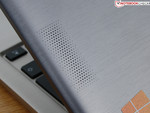
The integrated speakers (back of the tablet, at the edge) deliver reasonable sound at adjusted or maximum volume. The volume is pretty high (no distortions). When you carry the tablet around both hands are exactly above the speakers, but the sound does not suffer in these situations because the fingers cannot cover 100% of them.
Low tones and bass are not very inspiring, they are just not present. The sound is more mid tone focused. We did not like the automatic volume adjustment of the sound driver, we could clearly determine adjustments. For headphones there is a standard 3.5 mm audio jack that was combined with the microphone. The tablet also has an integrated microphone, for example, voice commands can be used for web URLs or search words.
Energy Management
Power Consumption
The energy consumption is between 1.6 - 4.2 Watts at idle and 5.8 Watts under medium workloads (3DMark2006). The very low consumption is comparable to ARM tablets (Vivo Tab RT TF600) or the X86-competition (Iconia W510 1.7-6.9 Watts at idle). The Samsung ATIV Smart PC (1.6-4.0) is more frugal although its display brightness is nearly identical.
Under high load the voltmeter only indicates 8.4 Watts. The W510 (9.7 Watts) is more power hungry; the rest of the competition is on the same level. Interesting: The TF600 with Tegra 3 and Windows RT needs even more power, 9.1 and 11 Watts respectively (medium, high; similar brightness). Intel Core devices like the Vaio Duo 11 with i5-3317U need 5 - 11 Watts at idle and 34 Watts under load. In return the performance is significantly higher compared to our Intel-Atom system.
The 10 Watts power supply unit is sufficient for the consumption. During continuous load and utilization of the PSU the following charging times could be longer.
| Off / Standby | |
| Idle | |
| Load |
|
Key:
min: | |
Battery Runtime
Just recently the Envy X2 11 with its dual batteries delivered massive runtimes of 7:07 and 11:55 up to 20:34 hours (load/WLAN/idle). These runtimes can be beaten by our review unit. 33 hours (tablet+dock) is the result for the Reader-test, the consumption was minimized by turning off all wireless connections and the lowest brightness. The runtime measurements became an ordeal because the limited energy settings of Windows 8 (there is just one energy profile!) caused the tablet to go into unintentional standby quite often. When we only used the tablet this could be avoided with the "Don't Sleep" tool, but it did not always work when the keyboard dock was attached. Due to these problems we did not get a correct result for the WLAN test even after several days of testing.
Based on our evaluation the most realistic runtime is determined by the "Movie 150 cd/m²" scenario. The tablet shows a low resolution AVI movie for almost 14 hours (830 minutes). With the docking station this value is increased to 18:20 hours (1,100 minutes). The worst scenario under load (only tablet, maximum brightness) is seven hours (425 minutes). The Reader-test (idle) without docking battery stops after 10:41 hours (641 minutes). The docking station is no charging station; the tablet cannot be recharged with the second battery.
There is one disadvantage with two batteries: the pretty weak 10 Watts PSU needs 6:10 hours (both batteries) and 4:07 hours (only tablet battery) for a complete charge (device is turned on). The 2-cell tablet battery has a capacity of 30 Wh (lithium-polymer, 3,950 mAH). The battery beneath the keyboard provides 25 Wh (two cells).
The competition, also with dual batteries, cannot keep up with these runtimes: Asus VivoTab RT TF600 (16:10 hours/10:18; idle/WLAN), Iconia W510 (19:09/13:35), Samsung XE500T1C (single battery, 14:43/7:14).
Verdict
Asus complements its Windows RT VivoTab TF600 (Tegra 3) with a device for traditional Windows fans, the VivoTab TF810C-1B026W including keyboard dock. But you really have to be a big fan; the extra charge of 350 Euros (~$467) is immense. For this price you get the X86-platform with real Windows 8. It is only 32 bit but it can run all familiar applications (no limitation to Windows RT apps).
At least in theory, similar to the HP Envy x2 11-g000eg, Acer Iconia W510 and Samsung ATIV Smart PC XE500T1C, the performance suffers from the weak Atom processor. If you want to use the TF810C as a desktop replacement on the go (multi-tasking, run apps simultaneously, save lots of data, casual games) you will reach the performance limits very quickly. This is the reason for the title "unbalanced": The TF810C is more expensive than some Intel-Core ultrabooks but computing speed and overall performance are almost similar to netbooks (Atom N2600 early 2012).
But the VivoTab TF810C has its advantages too. 33 hours idle runtime is unrivaled compared to other Cedarview-Atom devices. We can only estimate the WLAN runtime with an additional test: around 17 hours. These runtimes can be achieved with the additional battery in the keyboard dock. Other benefits are the keyboard, which is convenient for frequent writers and the robust, high quality aluminum finish of the base unit and tablet.
The potential buyer might be surprised by the low HD resolution (1366x768 pixels), but Atom convertibles from the competition do not offer something better (Envy x2 11, Acer Iconia W510 and ATIV Smart PC XE500T1C). If you want a higher resolution in the same or at least similar form factor (Windows 8) you have to choose an Intel Core based convertible, for example the Sony Vaio Duo 11 or Dell XPS 12. The S-IPS+ panel does not need to hide from the competition, it is very bright during battery use, has a very high contrast and wide viewing angles (best in class). The three listed competitors also have good displays but are not that perfect.
Similar (low) performance, identically good panels with the same resolution: Which Atom convertible is the best? With prices of around 900 Euros (~$1201) the Envy x2 11 and our VivoTab TF810C are the most expensive, yet they offer the best runtimes with the additional battery inside the keyboard docks. Acer Iconia W510 (500 - 600 Euros, ~$667 - $801) and ATIV Smart PC XE500T1C (under 800 Euros, ~$1068, without UMTS) are considerably less expensive. However, Samsung waives the second battery and with Acer the customer has to live with worse build quality and inconvenient input devices. In return, Acer integrated an additional battery and offers long runtimes. Asus does not want to scare off the customers and sells a technically identical VivoTab Smart ME400C for around 500 Euros (~$667, without dock).







